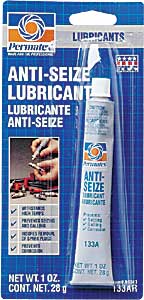 =
Trouble Maker
=
Trouble MakerDry Threads Vs. Lubricated Threads
NEVER, NEVER use anti-seize compound on fasterners--- Read on
 =
Trouble Maker
=
Trouble Maker
Test Set-up
A strain gauge was placed on a 1/4-28 bolt and torqued with a torque wrench to various values. The strain gauge could then read the amount of force on the bolt. Alternately, dry threads, threads smeared with moly paste, threads dipped in 10w-40 oil and threads with anti-seize compound applied to it was tested.
Testing Conclusion:
-Threads lubricated with 10w-40 oil gave the most consistent results.
-Placing 10w-40 oil on threads does not change the bolt tension.
-Threads with anti-seize paste added to it has as much higher tension (Up to 71% increase) than with dry threads. That extra tension could conceivably strip out the threads. This could be the reason why spark plug installation specify that a 3/4 turn after seating rather than a torque value.
-When you apply anti-seize to a fastener and torque it to 100in-lbs. The amount of force you put on the bolt is as if you just torqued the bolt to 170 in-lbs!! You are effectively putting too much force on the bolt.
-Base on test results, I would never use anti-seize on cylinder head bolts, or other critical fasteners other than spark plugs. If you have to use it, be sure to reduce the torque. I read from various sources that you should reduce it anywhere from 10% to 60%. I would reduce it by 35%. You would still be putting more tension on the bolt, but should be ok.
Details:
Most fasteners, I just torque by hand, and for the most part, it works. For critical fasteners, some manual call for lubrication with oil while other call for dry threads. Some don't specify either. For spark plugs, most people use anti seize compound on the thread to prevent galling. Sometimes, I use the antiseize on other components to prevent galling also. However, that is where I ran into problems which prompted this investigation. I use anti seize on the exhaust manifold studs along with the Stage 8 reusable locking fasteners. The thinking was that the locking feature of the Stage 8 fasteners is more than enough to lock the nut in place. The anti seize would keep the nuts from being frozen in place. Upon tightening the nut, I stripped out 3 studs.
At work, I was testing a bolt tensioner for a spacecraft mechanism. I had to put lubricant on the thread to prevent it from gaulling due to the high tension required on the mechanism. I wondered how effective the lubricant would be on the thread. I decided to run a few extra runs after work to determine the effects that lubricant has on bolt tension. The reasoning is that lubricant makes the nut more slippery, and therefore with the same specified torque that you apply to the nut per the manual, you would get a higher tension because of lower friction in the nut. The question was how much tension increase do you get.
The test set-up that I had had a ball bearing that the nut is sitting on. Therefore, the only friction is in the thread. The thread were 17-4PH Cond. H700, and the nut was 6AL-4V Titanium. The material does not represent your typical automotive fasteners. However, I was interested in comparing the difference between using and not using lubricant. Since the same material is used in all tests, it is assumed that different material will exhibit the same characteristics. Plus, I did not have the right material available.
The first test was to gradually torque the nut from 0 to 100 in-lbs., and record the tension. As seen from the graph above, the dry thread had a very steady increase in tension with increase torque. It was very predictable. The second test was with moly lube added onto the thread. Here there was some scatter in the data. The tension was not as predictable. The last test was with Permatex Antiseize paste. As seen on the graph, tension increase more dramatically at higher torque. The relationship was not linear. Previous testing with fasteners shows that when a fastener show sudden increase in tension, the tensioning of the fastener becomes unpredictable.
The second test was to torque the nut to 100 in-lbs several times to see how consisten the tension was.
Threads with anti seize applied have up to 71% more tension than dry or oil lubricated threads! More tension may not be better. It may strip out the threads.
I calculated the standard deviation for the results above. Standard deviation is a mesurement of how consistent you could achieve the results. The number indicate you have a 68% confidence that the next time you test, the standard deviation is the maximum that the result will vary by. The smaller the standard deviation the better. With anti seize, it was 71lbs. This is much higher than with dry thread, at 8 lbs. or with 10w-40, at 4 lbs.oil on thread. Therefore, putting 10w-40 oil on the thread gave the most consistent results without any significant increase in tension. A word of caution here is don't use these data as a correction factor for reducing torque on a fastener that has anti-seize applied to it. These tests are performed with the nut sitting on a ball bearing, so that part of the friction is not accounted for. However, the test is good for comparision purpose between different types of lubricant.
More information fasteners: